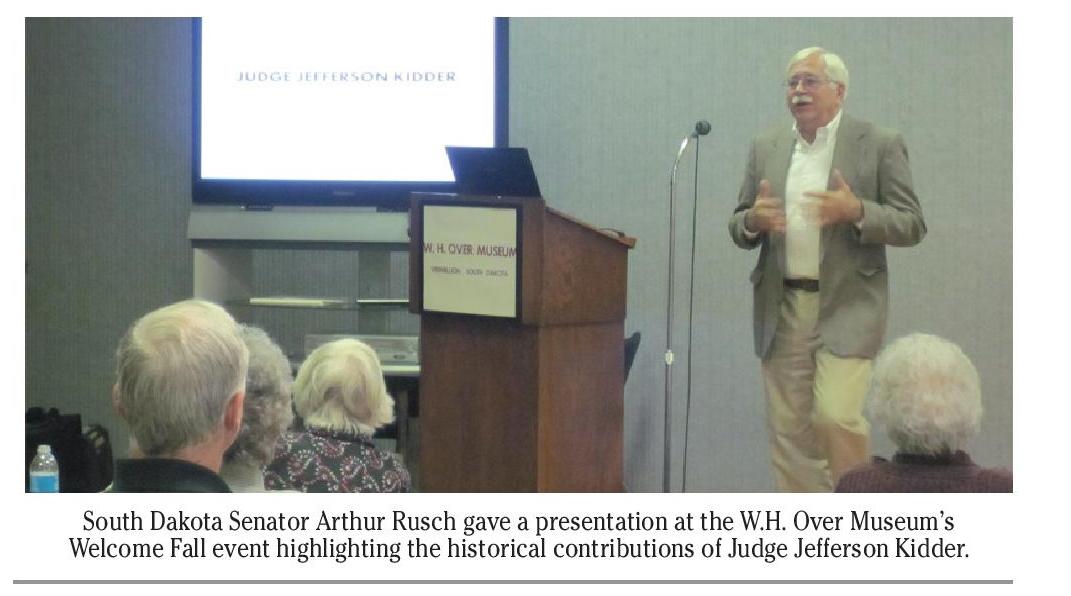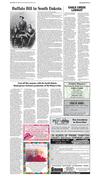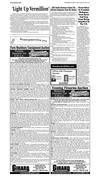112415_YKBP_A 2.pdf









2 Broadcaster Press
November 24, 2015 www.broadcasteronline.com
Jefferson Kidder’s
Mark On South
Dakota
By Sarah Wetzel
Speaking at the W.H. Over
Museum’s Welcome Fall
event this year, Senator Arthur Rusch chose to highlight
a historical figure who, in his
opinion, isn’t as well known
as he should.
“Jefferson Kidder came to
Vermillion in 1864,” he said.
“In my view he’s one of the
most significant figures, with
the possible exception of Senator Tim Johnson, who’s ever
come from Vermillion or lived
in Vermillion. He had more
of an impact on Vermillion,
more of an impact on Dakota
Territory than any other
person of that time.”
South Dakota wouldn’t
actually become a state until
1889 and according to Rusch,
Kidder’s influence helped
that along.
“The saying was if he had
lived into the time when
South Dakota became a state
that he probably would have
been one of the early governors or state senators,” he
said. “Then everybody would
remember him but he died a
little bit too early for that.”
Kidder has left his mark on
South Dakota in several ways.
“Most of you are from
Vermillion and you’re aware
of Kidder St,” Rusch said.
“There’s a Kidder St. in
Mechling too I think that was
named after him. If you’re really familiar with the Midwest
you’d know that there is a
Kidder County North Dakota
that ended up North of the
line when they divided up
North and South Dakota.
There’s a town of Kidder in
South Dakota which is East of
Marshall. Kidder was really
a significant figure but his
contributions have kind of
disappeared.”
Kidder’s main contributions
involved his work as a federal
judge during South Dakota’s
territorial days.
Kidder’s success is easily
seen judging by the unusually
long length of the time he
served.
“Federal judges in the territorial days were four-year
presidential appointments,”
Rusch said. “Most of the
federal judges appointed
in Dakota Territory got one
four year turn before their
political enemies were able to
do them in and they were not
able to get a second term. A
few judges who were very significant were able to get two
appointments before they
were not reappointed. Kidder
was appointed five times as
a federal judge here. Once
by Abraham Lincoln, twice
by Ulysses S. Grant, once by
Rutherford Hayes and once
by Chester Arthur. That last
one was just a few months
before he died.”
At the time Kidder was
a judge, Dakota territory
included all of North Dakota,
all of South Dakota, most of
Montana, most of Wyoming,
a little bit of Nebraska and a
little bit of Idaho.
The territory was divided
into three judicial districts
with Kidder presiding over
the district that ran from the
present-day Iowa line to the
Clay/Yankton county line
then north to Canada.
Vermillion was his headquarters with Kidder’s office
right on Broadway St.
“When he first came here
he had a house in town that
he used the front room as
a courtroom and his family
lived in the back,” Rusch
said. “Eventually after he’d
been here awhile he built
a house and when we first
came to town Mike and
Julia Chaney were living in
that house. The house was
originally one story and then
a second story was added
on. It was at the Northeast
corner of University where
University gets down to the
bottom of the hill. It was not
called University at that time,
it was called Kidder Hill.
That house was torn down
about 1980 I think and there’s
another house that has been
Waterproof Boots/Shoes
Over 20 Styles to Choose From And On Sale!
FREE
Socks
With
Boots
Boston Shoes to Boots
312 W. 3rd • Yankton • 665-9092
WJ Ranch 14th Annual
Cowboy Christmas
(7 mi. south of Yankton, SD just off Hwy. 81)
built in that location.”
According to Rusch’s
research, Kidder became
influential in several other
states before he ended up in
Vermillion.
Born in 1815 in Braintree,
Vermont, Kidder initially
began practicing law in
Vermont, becoming very successful.
“He was elected as a
delegate to Vermont Constitutional Convention,”
Rusch said. “He was elected
as a state attorney. He was
elected to Vermont state
senate. All of the time when
he wasn’t really very old. He
became regarded as one of
the most significant lawyers
in Vermont.”
But then his face turned
towards the West as one of
many who headed there for
better prospects though his
fortune had been good in
Vermont..
“Basically the democratic
party in Vermont kind of
imploded at that time over
the national party supporting
slavery and the Vermonters
were not at all interested in
supporting slavery like the
national democratic party,”
Rusch said. “The party disappeared and Kidder left and
moved to Minnesota at that
time.”
Kidder’s involvement in the
Minnesota Democratic Party
eventually led him to the area
which would become the
Dakota Territory.
“There was lots of money to
be made if you could get an
area developed and get the
lots claimed and get railroad
developers there,” Rusch
said. “So Minnesota Democratic party organized this
group to come out to Sioux
Falls and try to get recognized as a new territory there
in Sioux Falls because Dakota
Territory hadn’t been created
yet.”
Settlers had tried to become
recognized to no avail.
Kidder was unanimously
elected as territorial delegate
for the area.
“The way I understand they
cast votes is they would get
a wagonload of people and a
number of jugs of whiskey,”
Rusch said. “You would drive
out into the country until
you felt like you’d gone far
enough and then you’d stop
and they bring out the poll
books and everybody would
write in the names of everybody they could think of back
where they came from as the
votes then they’d drink some
whiskey and get back in the
Sat. & Sun., Nov. 28th & 29th
South Dakota Senator Arthur Rusch gave a presentation at the W.H. Over Museum’s
Welcome Fall event highlighting the historical contributions of Judge Jefferson Kidder.
wagon and they’d drive out
till they got thirsty again and
they’d stop and cast ballots.
There were a number of elections that were supposedly
conducted in that fashion.”
After becoming elected as
the territorial delegate Kidder himself failed to get the
area recognized as a territory
after 18 months in Washington.
“He was really an influential
person and knew a lot of the
people in Congress at that
time,” Rusch said. “The Republicans kept him from succeeding because they didn’t
want to see the Minnesota
Democratic party control this
new territory and secondly
the minnesota democrats
and missouri democrats were
feuding over this and the missouri democrats who had JBS
Todd and his partner which
were trying to build up settlements along the missouri river. so the Missouri Democrats
weren’t about to agree to let
the minnesota democrats get
recognized and control this
territory when they intended
to get control of the territory.
So with the Republicans and
half the Democrats opposing
him he just couldn’t succeed
in that.”
After this failed attempt Kidder resumed law practice in
Minnesota, eventually becoming elected to the Minnesota
House of Representatives.
While in office there Kidder
was one of the deciding votes
in favor of former governor
Ramsey to become a U.S.
Senator.
“Obviously Ramsey had a
big debt he owed Kidder and
the following year Abraham
Lincoln appointed Kidder
as one of the three federal
judges for Dakota territory,” Rusch said. “Kidder
then came on a steamboat
to Vermillion which he had
determined would be his
headquarters on the federal
bench and eventually got a
home here and his wife and
two sons moved.”
According to Rusch it was
actually only Kidder, his
wife and their younger son,
his older son serving in the
Union Army at the time and
their daughter married in
St. Paul. One young son had
passed away in Minnesota
as well.
A copy of Kidder’s appointment signed by Abraham
Lincoln is on display at the
Vermillion courtroom today.
The three major population
areas in Kidder’s jurisdiction
during that time was Vermillion which was the biggest
city in the territory, Sioux
Falls and Pembina, which is
now in North Dakota.
After a period of time Kidder
ran for a position as delegate
to Congress, this time from a
recognized territory and as a
Republican and was successful in his election.
Because of population
changes in the Dakota territory, the judgeship was
moved from Vermillion to
Sheradon then eventually to
Deadwood.
This would not be Kidder’s last time in Vermillion,
however.
Kidder served four years in
Congress then got done in by
political enemies in political
party so he didn’t get a new
nomination even though
was very well regarded and
popular.
“As kind of an indication of
how popular he was, Congress immediately created
a fourth federal judgeship
in Dakota Territory,” Rusch
said. “President Hayes
appointed Kidder to that
judgeship and they set it up
basically on the outlines of
the judgeship he had before
and set his headquarters in
Vermillion again.”
Kidder’s family life had been
riddled with tragedy.
Not only did his youngest
son die at the age of two, but
his son Lyman who served in
the Union Army and later as
a cavalry officer was killed in
Kansas in what’s known as
the Kidder Massacre.
A dress sword that Lyman
ordered before he died is on
display at the W.H. Over Museum in Vermillion today.
Kidder’s daughter also
passed away two months
after Lyman was buried, leaving two young children.
The first courthouse in
Vermillion was on Court St.
where the current post office
sits.
“Kidder was responsible
for the construction of that
courthouse on Court St,”
Rusch said. “He had a grand
jury investigate and the
grand jury’s report was that
the existing building where
the county kept their records
was about as cheap as could
be built. They finally built
that courthouse on Court St.”
Kidder was also instrumental in the University of South
Dakota’s initiation, even
arranging for first classes to
be held in the courthouse
because construction of Old
Main was unfinished.
“As far as all my research
goes USD is the only university to start in a courthouse,”
Rusch said.
November is National
Family Caregiver Month
10:00 a.m.-5:00 p.m. Both Days
•Horse Rides Begin at 1pm Daily
•Trick Roping Shows
He
See Me y Kids!
•Crafts For Kids
Satu
1-3pm rday
•Model T/Hayrack Rides
•Family Activities
•Refreshments
Clothing, Primitives, Jewelry,
Western Decor, Florals, Metal, Wood, Fabric,
Christmas Decor, Food Gifts & Much More!
When you need a break, HeartPrint Home
Care is available to provide Respite Care.
• Giving family caregivers a break to:
take a nap, run errands, go to personal appointments,
visit friends or other family members, etc
• Providing appropriate care and supervision to protect
your family member’s safety in your absence
• Available for short term or reoccuring basis
Any hour of the Day, Every day of the Year
Contact us for a FREE consultation
624-5900 • www.HeartPrintHomeCare.com
NO ADMISSION CHARGE!
See www.schiferlswjranch.com
BLACK FRIDAY
ENDS NOVEMBER 30
2015 FOCUS SE
MSRP
Friends & Neighbors Discount
Retail Cash
Ford Credit Cash
Black Friday Cash
TOTAL VALUE1
$
20,825
1,326
$
750
$
1000
$
750
$
$
16,999
or lease for $159 a month2
2016 FUSION SE
MSRP
Friends & Neighbors Discount
Retail Cash
Ford Credit Cash
Black Friday Cash
Package Discount
TOTAL VALUE1
$
2016 ESCAPE S
25,010
$
1,521
$
1,500
$
750
$
750
$
490
$
19,999
or lease for $189 a month3
MSRP
Friends & Neighbors Discount
Retail Cash
Ford Credit Cash
Black Friday Cash
Package Discount
TOTAL VALUE1
$
24,940
$
1,451
$
1,000
$
500
$
500
$
490
$
20,999
or lease for $229 a month4
2015 EDGE TITANIUM
MSRP
Friends & Neighbors Discount
Retail Cash
Ford Credit Cash
Black Friday Cash
Package Discount
TOTAL VALUE1
$
39,560
2,560
$
250
$
250
$
500
$500
$
$
35,500
or lease for $397 a month5
1
All prices exclude taxes, title and registration. Fmcc Financing may be required. All Cash Back applies to purchases. Friends and Neighbors price varies, based on vehicle selected. For all offers, take new retail delivery from dealer stock by
11/30/2015. See dealer for complete details.2 3 year/31,500 mile lease, $1,900 cash down, security deposit waived. 3 3 year/31,500 mile lease, $1,900 cash down, security deposit waived.4 3 year/31,500 mile lease, $1,900 cash down, security deposit
waived.5 3 year/31,500 mile lease, $1,900 cash down, security deposit waived. W.A.C.
VERMILLION
YOU CAN COUNT ON US...
605.624.8624 • 101 West Cherry
Donny Stewart
605.202.0424
Dan Van Osdel
605.661.1320
Tom Taggart
605.670.8682
www.VermillionFord.com
“Kidder was largely responsible for getting the university going. There was the flood
in 1881 and Vermillion had
been pretty much destroyed.
The legislature had authorized the University 20 years
before that but nobody had
ever taken any action to get
the university going. Kidder
was the one to take that action to get it going. He had a
meeting in his office. Kidder
drew up the Articles of Incorporation for that and Kidder
agreed to donate 10 acres
of land which had been the
homestead land for his son
Lyman for the first campus.
People in town then raised
enough money to buy another 10 acres so they had 20
acres to start the campus on.
Kidder drew up all the legal
work to get that done. Kidder
was the one that got that all
approved by the state.
“They board of regents actually contacted Kidder to see if
he would be willing to serve
as the President. Apparently
not because it was just a
few months before he died
that offer was made to him.
He was the one who located
the first president, Epstein
and made arrangements for
him to come and get the
university going and he was
also head of the building
committee that supervised
the construction of Old Main
during that time.”
Kidder made 100 speeches
around Clay County to
encourage voters to approve
the bond issue with which
Old Main was built.
“That was the first Old
Main,” Rusch said. “That
was one wing of the existing
building. Once they occupied
that then they put on the
other branches. One of the
associates that worked with
him on getting that approved
was John Jolley and of course
he’s more well known because there’s a school named
after John Jolley.”
After Kidder passed away
he was buried in St. Paul,
Minnesota.
Kidder County, North
Dakota, was named the same
year he died.
His wife, also buried in St.
Paul, preceded him in death
having succumbed to Tuberculosis. .
“She had suffered from
that for a number of years in
Vermillion,” Rusch said. “It
was quite a moving letter that
he put in the paper when his
wife died thanking all of the
women in Vermillion for the
kind care they had given to
his wife during the time she
had suffered from Tuberculosis.”
Kidder’s only surviving
child, Silus, eventually became mayor of Vermillion.
“If you go down and talk
to people from the city, the
picture they have of Silus
in their pictures of mayors
is not Silus but a picture of
Jefferson Kidder,” Rusch said.
“We’ve been trying to find
a picture of Silus to replace
that. We really haven’t been
able to find a picture big
enough we could blow it up.”
Two of Silus’ children died
at a young age within six
months of each other and are
buried at Bluffview Cemetery
under a single marker.
More tragedies awaited the
Kidder family as Kidder’s
grandson Jeff was killed as an
Arizona Ranger and another
grandson died in a tragic car
accident after returning from
service in the first World War.
“The Kidders were probably
among the wealthiest, most
influential people in Dakota
Territory through this whole
time,” Rusch said. “Yet that
wasn’t enough to protect
them from awful family tragedies and certainly they had
more than their fair share of
those.”
Rusch intends to make it a
personal goal to ensure Kidder’s contributions are more
widely known.
“I think Kidder is a significant figure and he has not
been recognized the way he
should,” he said. “Most of
you know I’ve written a book
about courthouses. I’ve decided my next project will be
to work on a biography of Jefferson Kidder so that people
could become aware of his
history and background and
the benefits he gave to this
community.”






















 Previous Page
Previous Page






